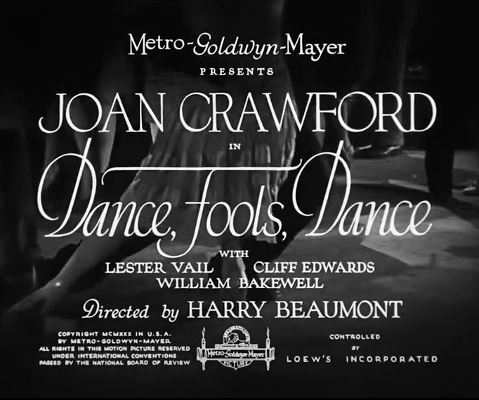
The Best of Everything
Encyclopedia Entry • Films Main
Dance, Fools, Dance
1931

Critics' Reviews • Our Reviews • Movie Posters • Lobby Cards • Misc. Images
Click here to see photos from the film.
US general release: 2/21/31.
VHS release: 3/27/91. Warner Archive DVD release: 3/23/09 Warner Archive Blu-ray release: 10/31/23 Cast: Joan Crawford (as "Bonnie Jordan"), Lester Vail, Cliff Edwards, William Bakewell, William Holden, Clark Gable, Earle Fox, Purnell B. Pratt, Hale Hamilton, Natalie Moorhead, Joan Marsh, Russell Hopton. Credits: From the story by Aurania Rouverol. Continuity: Richard Schayer. Dialogue: Aurania Rouverol. Director: Harry Beaumont. Camera: Charles Rosher. Editor: George Hively.
Plot Summary: Joan Crawford and William Bakewell play the spoiled-rotten grown children of stockbroker William Holden. When Wall Street lays its famous egg in 1929, Crawford and Bakewell find that they can no longer pursue their flamboyant lifestyle (for example, they'll have to put a moratorium on the sort of "lingerie parties" with which this film opens). Crawford gets a newspaper job, while Bakewell ties up with vicious bootlegger Clark Gable. When Gable is implicated in the murder of seven gangsters (a transparent reenactment of the St. Valentine's Day Massacre), Crawford's fellow reporter Cliff Edwards gets proof of Gable's complicity. Bakewell is ordered to kill Edwards; Crawford, not knowing of her brother's actions, takes Edwards' place, wooing Gable in hopes of getting a scoop. When Gable finds out that Crawford's working undercover (so to speak), he prepares to rub her out, but her life is saved by Bakewell at the cost of his own. Compared to the rest of the stick-figure leading men in Dance Fools Dance, Clark Gable stood out like a testosterone-soaked thumb, and it wouldn't be long before he'd be promoted from villains to heroes. ~ Hal Erickson, All Movie Guide
Notes: • The film began production on 11/4/30. • It cost approximately $289,000 to make and returned more than $900,000 in profit (Ultimate Star). • An initial title for the film, which was printed on some lobby cards, was Key to the City. • This was Joan's first of eight films with Clark Gable. He was billed sixth.
|
Mordaunt Hall in the New York Times March 21, 1931 Probably "Dance, Fools, Dance" is a good title as motion-picture titles go, but a metaphysician might exhaust his learning trying to reconcile it with the melodrama of newspapers and gangdom in which Joan Crawford is featured at the Capitol. Outside of that and a number of incredible turns in a strictly made-to-order plot, the new picture is a brisk and lively entertainment of its sort, and it brought scattered applause from a thin audience at its first showing yesterday. The scenes of a city room in a metropolitan daily are authentic. The story draws for its drama on two high spots in Chicago's recent crime history—the shooting of Jake Lingle and the celebrated St. Valentine's day massacre. Miss Crawford, as Bonnie Jordan, goes to work as a cub reporter after her wealthy father loses his fortune in the market. Her brother Rodney, a shiftless youth, gets mixed up with a beer-running gang, and is the man at the wheel of the car from which a machine gun mows down seven members of a rival gang. The star reporter, played without the aid of a banjo by Cliff Edwards, is put on the story, learns too much, and is murdered. The paper offers a $25,000 reward for the capture of the murderers. Bonnie is sent out to gain the confidence of the suspected gang chief, Jake Luva, and what happens thereafter is just about what four out of five will suspect at this point in the film. The love motif presents Lester Vail as an heir to millions who regards Bonnie as an empty-headed playgirl, while she has money, and who discovers his love for her only after she has gotten along very well without his aid. Clark Gable's characterization of the gang chieftain is a vivid and authentic bit of acting, and Mr. Edwards makes an interesting reporter. Miss Crawford's acting is still self-conscious, but her admirers will find her performance well up to her standard. William Bakewell never loses sight of the fact that his part calls for a hard-drinking young weakling. On the whole, Harry Beaumont, for his direction, deserves most of the applause for "Dance, Fools, Dance."
John Campbell in the New York Times (after a showing of DFD at a French film festival) January 10, 1932 ...Another film which has attracted attention in the past fortnight has been "La Pente." This is the dubbed version of "Dance, Fools, Dance" and marks the first of the Metro-Goldwyn-Mayer films completed in Hollywood under their new system. It is also the first appearance of Joan Crawford and Clark Gable here in talking pictures for the French public, although several of their films have been released in small houses in the original versions. For the first time the critics have been lenient with dubbing. Eleven out of fourteen recommended the picture, with the result that the box office records of the Folies-Dramatiques have been shattered. One critic predicted that Gable would become an idol of such importance in France within eight months that he will soon be acclaimed the new Valentino. And it appears to be the presence of the two stars rather than the story of this film—considered by the French to be too brutal—that will make the picture a success throughout French-speaking countries.
Loew's Weekly (April 18, 1931): Joan Scores in High Powered Story of Society and Gangland
"Dance, Fools, Dance," coming next week, presents Joan in her most glamorous role, that of a society debutante who turns newspaper reporter and tracks down a murderer in a gangland war.
As Bonnie Jordan, petted child of society, Joan reverts to the insouciant charm of her Dancing Daughter interpretations. As Bonnie, the struggling newspaper reporter forced to earn her living thru her father's loss of fortune and subsequent death, she typifies the ideal American girl out on her own and determined to make good. Sheer drama and a plentitude of thrills are provided when her paper gives her the chance to help solve the murder of their ace reporter by a gangland czar. Joan tackles the job in her own fashion by securing a place as featured dancer in the man's favorite nightclub. She tracks down the murderer as the story moves to one of the most gripping climaxes ever screened.
Interesting characterizations are offered by Cliff Edwards as the newspaper man who is murdered, by Lester Vail as Joan's sweetheart, by Clark Gable as Luva, the underworld king, and by William Bakewell, who, as Joan's shiftless brother, furnishes the story with its dramatic motivation.
Photoplay (1931) Again Joan Crawford proves herself a great dramatic actress. The story... is hokum, but it's good hokum and Joan breathes life into her characterization.
Harry Marshall of harrys-stuff.com (2003) Dance, Fools, Dance was conceived as a Crawford vehicle - and she certainly lives up to it. This film will set her on a new path, the "strong woman," and will lead her to films like "Rain" and "Sadie McKee." In Dance, Fools, Dance we see the on-screen persona of the true star - we can believe in her as the character Bonnie Jordan, but we are also always aware we are watching Joan Crawford. And her dancing is not bad either.... |
If you've seen Dance, Fools, Dance and would like to share your review here, please e-mail me. Include a picture of yourself or avatar to accompany your review, as well as a star-rating (with 5 stars the best) and any of your favorite lines from the film.
|
Rating:
Dance, Fools, Dance (1931) occupies a place in cinema history as the first on-screen pairing of the Queen and King of Golden Age Hollywood: I speak, of course, of Joan Crawford and Clark Gable. Joan stars while Gable--playing a bootlegger--is just starting his reign.
Joan plays Bonnie Jordan, a spoiled rich girl who likes partying, swimming in her skivvies, and trying out love “on approval.” When her dad’s fortune and life are lost in the stock market crash, Bonnie’s gilded life is tarnished. There is a poignant scene in which former friends descend upon her house like a horde of locusts, pawing and gawking at her belongings, which must be auctioned off to satisfy creditors. After rejecting a pity proposal from her boyfriend--played by Lester Vail--Bonnie decides to make a go of it as a working girl. This is 1930’s Joan after all!
Bonnie lands a job as a reporter through a family friend; although she harbors dreams of exposing criminal rackets, she starts at the bottom writing stories about poultry shows. Bonnie's perseverance is contrasted to that of her brother Roddy (William Bakewell), a dissolute wisp of a man-boy who takes a path of less resistance and works for a hoodlum (Gable as Jake Luva). Roddy leverages his high society connections to help Luva expand his empire.
When reporter Bert (Cliff Edwards) is murdered by one of Luva’s henchmen, Bonnie goes undercover to crack the case. This sets up the movie's conflict and resolution. How it turns out, I encourage you to watch.
Among the supporting cast (apart from Gable, who was 6th-billed), Bakewell does a nice job in a thankless role. He and Joan co-starred in her silent West Point (1927). Bakewell also had a small role in the beginning of Paid (1930) as the lawyer of the railroaded Joan/Mary. Bakewell went on to a long career as a character actor.
This is one of the most quintessentially pre-Code films of Joan’s from that era. DFD is based on a play by Auriana Rouverol, who also wrote the play upon which the wholesome Andy Hardy series was based (from which DFD could not be more different!).
I would rate Joan's performance here below those she gave in Paid (1930) and Rain (1932). Likewise, this is early Gable and the suave machismo he brought to later roles is not in evidence in DFD. If you have seen the excellent Night Nurse (1931), Gable more or less reprises the same role here, but instead of thuggish Nick the Chauffeur, he’s now thuggish Jake the Bootlegger. However, this is a “must watch” movie for JC or CG fans--not for the acting, but for the chance to see Crawford-Gable magic in its earliest incarnation. When they’re on the screen together, the sexual tension between them is palpable. In the speakeasy scene in which Joan is dancing about in her short dress, Gable eyes her like a starving wolf does a steak! The word “chemistry” is thrown around a lot, but the Crawford-Gable pairing transcends mere chemistry and is more of a nuclear reaction. The screen crackles when they’re both on it, and that’s reason enough to watch this movie.
3.5 stars. 2.5 stars because it’s an OK pre-Code gangster pic--albeit not on a par with what Warner Bros. was putting out--and an additional star because of the Crawford-Gable sizzle.
Rating:
To preface my review: The Market Crash of 1929 is a watershed moment in American history, along the lines of the Civil War. With each such major upheaval, American society was shaken to its core: Not just the system, but also individuals: Who would survive, and how? The epic Gone with the Wind addressed the aftermath of the fall of a civilization on both a grand and personal scale, albeit 75 years after the fact. The Crash of '29, though, took place amid the then-new media of cinema, which immediately made its more-shallow (though not necessarily less-accurate) pronouncements on winners and losers.
While watching Dance, Fools, Dance, I did keep seeing Joan's "Bonnie Jordan" as a low-rent version of "Scarlett O'Hara." Like Scarlett in the early scenes of GWTW, Bonnie is a sharp-witted, mildly bored party girl with an indulgent daddy; pre-Crash, she's concerned primarily with dancing and partying on Daddy's yacht, and toying with men's affections. (Though in the early '30s, the young, modern, rich Bonnie actually smokes and lounges around in dressing gowns in front of her beaus, unlike pre-war Scarlett in 1861!)
Post-Crash, and after her father dies of a heart attack on the trading floor and leaves his kids with nothing, Bonnie and her brother Rod (William Bakewell) are both forced to consider how they will survive: Rod only wants to continue to party and drink, and expresses his unwillingness to work; and the executor of her father's estate advises Bonnie to marry well... Bonnie briefly meets with her rich former party-boyfriend Robert (Lester Vail), whom she'd formerly toyed with in a Modern way: "I believe in trying love out...on approval." He's a gent, and does offer to marry her, but she senses that his heart's not in it and (in accordance with her own previously expressed philosophy) turns him down. She's also disgusted by her former rich friends picking over her family's belongings at auction and making sarcastic comments about her downfall, and so resolves to make a new working life for herself.
We're introduced to her new profession as a cub reporter by a cleverly shot scene showing only the type-writer story pages of various reporters: A country-club party, gangland wars, and a poultry festival. The first two shots are typed zippily (and are clever references to both Bonnie's early life and her gangland involvement to come), while the third shot of the poultry-fest article---typing by Bonnie, as we find out---is clunky with mis-spellings.
In the meantime, weak-willed brother Rod has taken up with gangsters in the hope of making an easy living via bootlegging. A sociological message from a gangster to the weak Rod as he's being inducted into the gangster lifestyle, yet expressing concerns that the business isn't "legit": "This is a legitimate business. Only we make our own laws. We don't let any small-town Senator make 'em for us. That's the only difference." (Shades of The Godfather!)
It's here, about 1/2-hour into the film, that we first set eyes on Clark Gable, gangster boss Jake Luva. He's first framed in a doorway, un-mustachio'd, and looking quite handsome and menacing, especially as he proceeds to blow cig smoke in the face of his current moll (Natalie Moorhead, who does a great job in her small role as the spurned girlfriend) after she's apparently paid too much attention to Rod. (NOTE: This film is touted elsewhere as being Gable's "first co-starring film" or even as his "first leading role." Neither is true. He's sixth-billed here. He doesn't appear on the film's title screen: Joan appears above the title, and Vail, Cliff Edwards, and Bakewell appear below the title. On the film's credits page, Gable is billed sixth.)
As brother Rod involuntarily takes part in a gangland massacre (based on the real-life St. Valentine's Day Massacre of 1929, and not shown on screen), reporter Bonnie is simultaneously assigned to infiltrate the gang after her fellow likeable newspaper reporter (Cliff Edwards) is murdered... Now Joan and Clark get to interact for the first time onscreen: She's been hired as a chorus girl in his club and does a hot dance---former beau Robert is present, along with other former high-society friends, and all are shocked to see her; she's initially shocked herself to see them, but recoups and blows right by Robert to sit at Jake's table, where they proceed to make out and then dance sensually. Says Jake: "You're going to have a little supper with me tonight. Upstairs in my room..." Says Bonnie: "I'd love it. I'll go undress right now." (Yes, there's plenty of chemistry and some personal silliness not in the script---after Clark's told her he's going to meet her upstairs, Joan makes a very funny---unscripted---face before she races off!)
Plot machinations after this, I'll leave for you to watch!
This is a tightly plotted and well-written little film. Film-historically, most important because it was the first of eight pairings of Crawford and Gable, but also just in and of itself a well-done minor personal and crime story, as well as a sampling of what might have been a more-expansive post-Crash story. Joan is good---still a bit eye-popping when emotional, but good. (She actually looks more lush in the previous year's Paid, and is a better actress in that film, as well, but...overall, Dance, Fools, Dance is the better movie.)
Joan/Bonnie's scenes with rich boyfriend Robert (Lester Vail) are also well-acted: Initially, she was giving him the run-around; then she was giving him a way out; then finally she was daring him to reject her after seeing her as a show-girl...Vail is a staid actor but true to his conservative rich-but-honorable role, and Joan reacts as intimately as possible to him in the conservative ending. And Joan's scenes with Gable are sexy AND also true to her film character. It's clear, though, that Vail was of the old film school and Gable of the new---going forward, the studios would pay much more attention to sexual chemistry and naturalism in acting, rather than old-fashioned stage tropes, when it came down to who ended up with whom at the end!
Rating:
A perfect movie of the times and of the genre. Miss Crawford moves in to the '30s with her drive for perfection strictly in focus, and MGM guides their young investment with roles for growth and public consumption.
This is a film that can get better after more than one viewing. It does have the "early talkie feeling" in photography and sound recording; however, most films of that time had that awkward balance. Miss Crawford jumps over the cables and the confusion of the sound stage to deliver a performance that is quite fetching at times. She is still rough around the edges but ripening before our very eyes and the audience's, too!
The writers supplied a script with everything: the stock market crash of 1929; the Depression; high society and the class system, including judgment and limitations, bitchy jealous women, bootlegging, gangsters, murder, unrequited love, sex, innuendo, dancing, and speakeasies, journalism, reporters, sibling relations, death of a parent, danger and intrigue -- everything but cowboys and Indians! After 80 years, this film and our lives have not changed that much!
Hollywood has not changed too much, either. Miss Crawford’s character, after losing her father in the stock market crash, gets a job at a newspaper to help get rid of a gangster, played by Mr. Clark Gable (this film marks the duo's first film appearance together -- and we know what that led to!).
Well, of course she gets a job in Gable's night club in true Hollywood tradition and dances with a bevy of chorus girls as the lead dancer -- that is fast action and advancement! If she drove a car in this film she would always get a parking spot in the busiest city. No matter. I just went with the fun.
My enjoyment of this film includes those familiar character actors Miss Crawford is often graced with, most of whom came from vaudeville and early American theater. My cinema sentiment loves Cliff Edwards (Montana Moon), Purnell Pratt (Grand Hotel), and Natalie Moorhead (The Thin Man and an uncredited role in The Women), who dated fast but got a nice close-up and smoke blown in her face by Gable. The script dumps her after a few moments and she disappears. Miss Moorhead sadly never got a chance to perform a good role as changes in Hollywood and the fickle public moved very fast.
William Blakewell, as Joan’s brother, plays a lazy, soppy, weak, impressionable alcoholic with great skill and redeems himself in the end by killing bad guy Gable and saving Joan and the memory of the reporter Gable had killed. Lester Vail plays Joan’s love interest, whom some might think rather dull. However, he had success on Broadway as an actor and director, ending his days on The Donna Reed Show! Miss Crawford was lucky to learn from many artists of her day.
I enjoyed Miss Crawford’s dancing costume; her dancing was perfectly suited to the times and to Mr. Gable’s night club. She really does sparkle here with a vivacity that is energizing and performs in the fashion we expect. She catches Mr. Gable’s eye -- and probably something else, too! I hope you see what he saw!
Stephen (January 2007) Dance Fools Dance is one of Joan's better early sound films. It starts out with Joan as a rich jazz baby partying on a yacht with other young ne'er-do-wells. It's easy to partake of the fun and the risque lingerie show. After the stock market crash, and Joan's dad's subsequent death by heart attack, Joan has to go to work as a newspaper reporter. Her brother gets a job with the mob. Joan goes undercover as a dancer at a mob dive to get a story. She meets Clark Gable and sparks fly. Joan does arguably her best dancing in this film. She's young, sexy and fun. Clark on the other hand is menacing and a treat to watch. One of his molls, Natalie Moorehead, lights his cigarette and in gratitude Clark blows smoke in her face. But the tables are turned when Clark lights Joan's cigarette and she pays him back in kind by blowing smoke in his face. I won't spoil the ending but Dance Fools Dance is worth 2 hours of your time. Joan's monumental magnetism comes through loud and clear and even overshadows Gable's much-ballyhooed magnetism. Rent it today. Or better yet buy the vid.
|
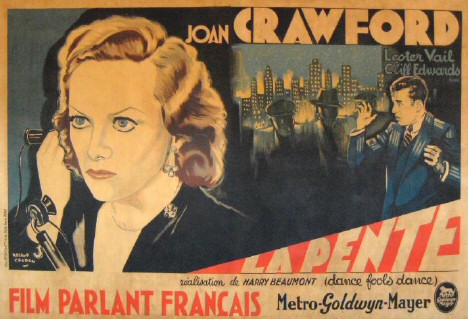
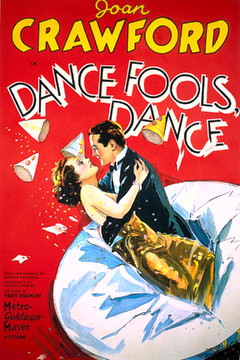

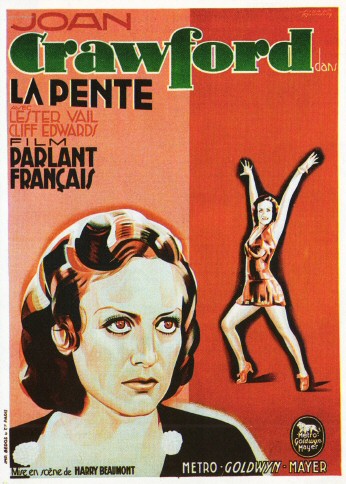
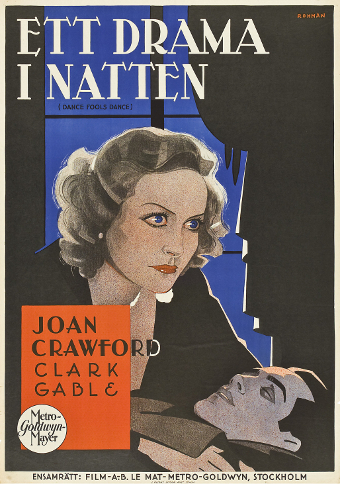


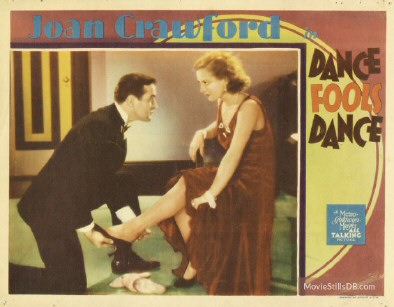
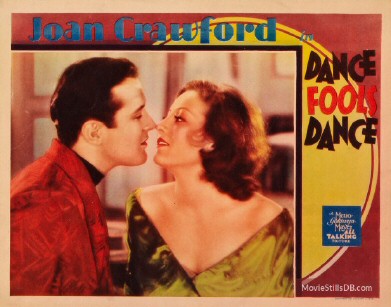

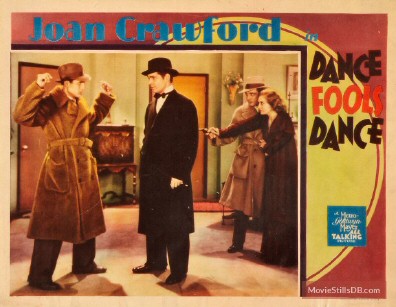

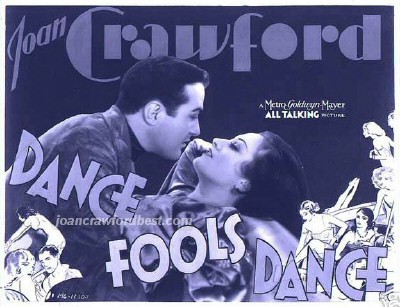
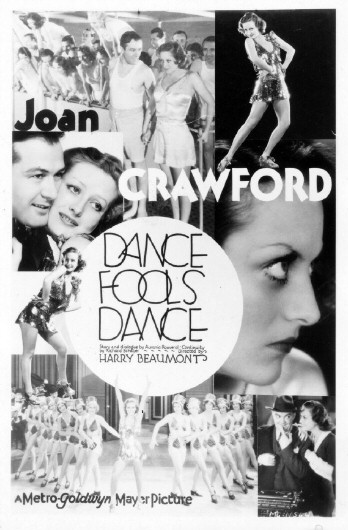
Above: An MGM photo-montage publicity card.


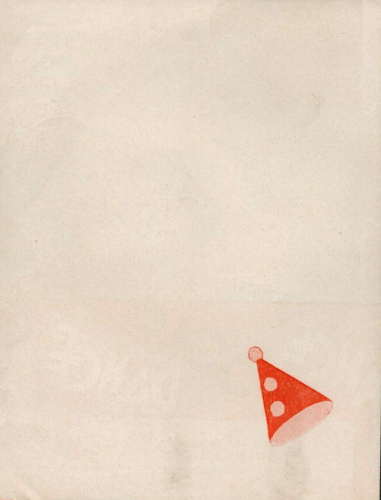
Above: US herald covers and centerfold.

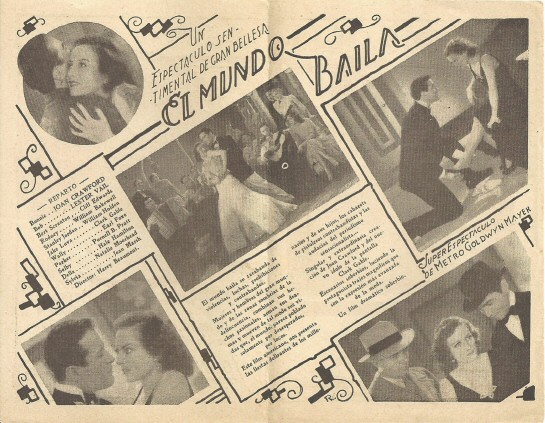
Above: A herald from Uruguay.
Below left: Danish program cover. Below right: Pelham, New York, window card.


Below: Two US newspaper ads, and a UK magazine ad (Film Weekly).

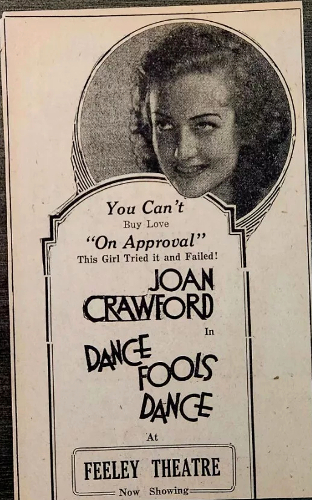
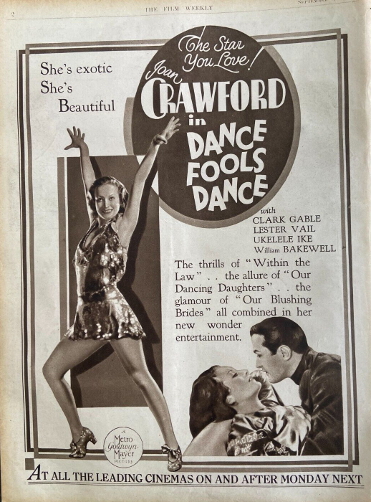
The Best of Everything